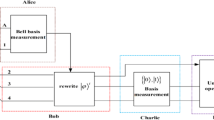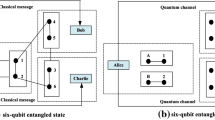Abstract
In this article, a scheme for quantum teleportation of a two-qubit entangled state using four-qubit cluster state is discussed by use of cavity quantum electrodynamics (QED) involving the interaction of the atoms with the cavity. In this protocol, by using a one-dimensional maximally four-qubit cluster state as quantum channel, quantum information of an unknown state of two two-level particles is faithfully transmitted from a sender (Alice) to a remote receiver (Bob). According to the results measured by the Bob, as it is shown, the unknown two-particle entangled state can be teleported perfectly, and the successful possibilities and fidelities of the scheme can reach 1.0.
Similar content being viewed by others

Explore related subjects
Discover the latest articles, news and stories from top researchers in related subjects.Avoid common mistakes on your manuscript.
1 Introduction
Quantum entanglement plays an important role in quantum information science. Entanglement is considered as the fundamental resource of quantum information processing such as quantum teleportation, quantum dense coding, quantum secret sharing, and so on. Quantum teleportation [1–3], first proposed by Bennett et al. [4] and experimentally realized by Bouwmeester et al. and Boschi et al., can transmit an unknown quantum state from a sender to a receiver at a distant location via a quantum channel with the help of some classical information. In 1993, Bennett et al. first presented a quantum teleportation scheme. In the scheme, an arbitrary unknown quantum state in a qubit can be teleported to a distant qubit with the aid of Einstein-Podolsky-Rosen (EPR) pair. Their work showed in essence the interchangeability of different resources in quantum mechanics. Later, in 1998, Karlsson and Bourennane [5] presented a protocol of teleporting two qubits state using GHZ state instead of an EPR pair. In their scheme, conditioned on one receiver’s measurement outcome, the other receiver can recover the arbitrary quantum state initially in the sender’s qubit. This means different resources can be exchanged in a control manner. Since the theoretical protocol for teleportation of a single qubit, many protocols of quantum teleportation are proposed and have been demonstrated experimentally by several groups [6–9]. With the development of quantum physics, the information techniques based on quantum physics have been actively studied. Recently, more and more attentions are paid to the study of quantum teleportation with many-particle entangled state. Xiu et al. [10] proposed a teleportation protocol of an N-particle state via three-particle general W states. Lu and Guo [11] proposed a protocol for the teleportation of two-particle entangled state via entanglement swapping. In above quantum teleportation schemes, the entangled states as quantum channel are EPR pairs, GHZ class states, or W class states. Actually, there are many forms of quantum channel, which are not reducible to a pair of Bell states can be employed for a perfect teleportation arbitrary two-qubit state. Recently, Yeo and Chua [8] present a protocol for faithfully teleporting an arbitrary two-qubit state via a genuine four-qubit entangled state. By construction, their four-partite state is not reducible to a pair of Bell states. Tripartite entangled states can be classified into two inequivalent classes, the Greenberger-Horne-Zeilinger (GHZ) class and the W class. While, the four-particle entangled state was divided to different families of states under stochastic local operations and classical communication. Recently, Briegel and Raussendorf [12] introduced an interesting type of multi-qubit entangled states, i.e., the so-called cluster states. This kind of states have high persistence of entanglement, and can be regarded as an entanglement resource for the GHZ states but are more immune to decoherence than them. The cluster states have extensive applications in quantum physics. Many theoretical schemes of generating cluster states have been proposed in different types of physical systems, such as cavity QED [13], linear optical systems [14], and other kinds of systems [15]. Experimentally, Walther et al. [16] have generated four-photon cluster states and demonstrated the feasibility of the one-way quantum computation. Mandel et al. [17] prepare the cluster state of neutral atom in optical lattice. On the other hand, the microwave cavity QED, with Rydberg atoms crossing superconducting cavities, provides an almost ideal system for the realization of quantum information processing. Cavity quantum electrodynamics (QED) technique has been proven to be a promising candidate for the physical realization of quantum information processing. The cavity usually acts as memory in quantum information processing, thus the decoherence of the cavity field becomes one of the main obstacles for the implementation of quantum information in cavity QED. In cavity QED, schemes have been proposed for teleportation of an unknown state. Davidovich et al. [18] have presented a scheme for the teleportation of an unknown atomic state between two high-Q cavities. Zheng [19] has proposed a scheme for teleporting an unknown atomic state in cavity QED.
In this paper, we have presented a new method for faithfully teleport a two-qubit state employing genuine four-qubit entangled states that four-partite state is also not reducible to a pair of Bell states in driven cavity QED. The probability of the success can reach 1.0.
2 The Teleportation of an Unknown Two-Qubit Entangled State
In this scheme, suppose the state to be teleported has the following form
where b and c are unknown parameters, |b|2+|c|2=1. |e〉 and |g〉 are the excited and ground states of the atom. The quantum channel between Alice and Bob is a one-dimensional maximally four-atom cluster state (Atoms 3, 4, 5, 6) which is in the following state
where the sender Alice has the atoms 1, 3 and 2, 5 and the other atoms 4, 6 belong to the receiver Bob.
Thus the total state of the system can be expressed as

In order to help Bob to realize teleportation, Alice sends atoms 1, 3 into a single-mode cavity and atoms 2, 5 into another cavity. At the same time, the two atoms are driven by a classical field. The interaction between atoms and the cavity can be described as follows [20]
where ω 0, ω a and ω d are atomic transition frequency, cavity frequency and the frequency of driving field, respectively, a † and a are creation and annihilation operators for the cavity mode, g is the coupling constant between atoms and cavity, atomic operators \(S_{j}^{+}=|e\rangle_{j}\langle g|\), \(S_{j}^{-}=|g\rangle_{j}\langle e|\), \(S_{j}^{z}=\frac{1}{2}(|e\rangle_{j}\langle e|-|g\rangle_{j}\langle g|)\), Ω is the Rabi frequency of the classical field. We consider the case ω 0=ω d . In the interaction picture, the evolution operator of the system is
where \(H_{0}=\sum_{j=1}^{2}\varOmega(S_{j}^{-}+S_{j}^{+})\), H e is the effective Hamiltonian. In the large detuning \(\delta\gg\frac{1}{2}g\) and strong driving field, 2Ω≫δ,g limit, the effective Hamiltonian for this interaction can be described as follows:
where λ=g 2/2δ, δ is the detuning between ω 0 and ω a . From Eq. (6), we know H e is independent of creation and annihilation operators of the cavity mode and only have relation with atomic operators. So the effects of cavity decay and thermal field are all eliminated. We can choose \(\lambda t=\frac{1}{4}\pi\), Ωt=π by modulating the driving field appropriately. Hence the total state of the combined system is

In order to realize the teleportation, Alice should make a separate measurement on atoms 1, 3, 2 and 5. Without lose of generality, if Alice detects the atoms in the state |eeee〉1325, the state of atoms 4 and 6 will collapse into
where we have discarded the global phase factor.
Now Alice informs Bob of the result of the measurement by the classical channels, then Bob performs corresponding single-atom rotations on atoms 4 and 6 to recover the teleported state, Eq. (8) will become
Now the teleportation is successful. From Eq. (7), we can see that when atoms 1, 3 and atoms 2, 5 enter into the cavity, because every atom has two levels, 16 kinds of different separate states can be derived. It is evident that Bob must operate relevant unitary transformation against Alice different measurement results. All the possible states obtained after Alice’s measurement are orthogonal, so it completes the deterministic teleportation protocol. The total success probability is 1/16×16=1.0, and the fidelity of the output state is 1.0.
3 Summary
In conclusion, we have proposed a simple scheme to realize the teleportation of an unknown two-atom state by four-qubit entangled states that four-partite state is also not reducible to a pair of Bell states in driven cavity QED. Two atoms exist in single-mode cavity and are driven by a classical field. In our protocol, the quantum channel is composed of four-atom cluster state. Whereas generating cluster states have been proposed in different types of physical systems. The fact that, four-atom cluster states are realized in laboratory conditions makes our protocol experimentally achievable. Finally we have shown that the protocol does not involve apparent Bell-state measurement and is insensitive to the cavity decay and the thermal field. The probability of the success is 1.0. This may open a new perspective for the applications of cluster states in quantum information processing. Our scheme may be widely useful to the future quantum communication and experiment.
References
Nielsen, M.A., Chuang, I.L.: Quantum Computation and Quantum Information. Cambridge University Press, Cambridge (2000)
Shan, C.-J., Liu, J.-B., Liu, T.-K., Huang, Y.-X., Li, H.: Int. J. Theor. Phys. 48, 1516 (2009)
Mei, F., Feng, M., Yu, Y.F., Zhang, Z.M.: Phys. Rev. A 80, 042319 (2009)
Bennett, C.H., Brassard, G., Crepeau, C., Jozsa, R., Peres, A., Wootters, W.K.: Phys. Rev. Lett. 70, 1895 (1993)
Karlsson, A., Bourennane, M.: Phys. Rev. A 58, 1895 (1998)
Xiu, X.M., Dong, L., Gao, Y.J., Chi, F.: Commun. Theor. Phys. 48, 261 (2007)
Wang, X.W., Yang, G.J.: Phys. Rev. A 78, 024301 (2008)
Yeo, Y., Chua, W.K.: Phys. Rev. Lett. 96, 060502 (2006)
Xia, Y., Song, J., Song, H.-S.: Opt. Commun. 279, 395 (2007)
Xiu, X.M., Dong, L., Gao, Y.J., Chi, F.: Commun. Theor. Phys. 49, 905 (2008)
Lu, H., Guo, G.C.: Phys. Lett. A 276, 209 (2000)
Briegel, H.J., Raussendorf, R.: Phys. Rev. Lett. 86, 910 (2001)
Wang, X.W., Yang, G.J.: Opt. Commun. 281, 5282 (2008)
Nielsen, M.A.: Phys. Rev. Lett. 93, 040503 (2004)
Cho, J., Lee, H.W.: Phys. Rev. Lett. 95, 160501 (2005)
Walther, P., Resch, K.J., Rudolph, T., Schenck, E., et al.: Nature 434, 169 (2005)
Mandel, O., Greiner, M., Widera, A., Rom, T.: Nature 425, 937 (2003)
Davidovich, L., Zagury, N., Brune, M., et al.: Phys. Rev. A 50, R895 (1994)
Zheng, S.B.: Phys. Rev. A 69, 064302 (2004)
Zheng, S.B.: Phys. Rev. A 68, 035801 (2003)
Author information
Authors and Affiliations
Corresponding author
Rights and permissions
About this article
Cite this article
Shao, Q. Quantum Teleportation of the Two-Qubit Entangled State by Use of Four-Qubit Entangled State. Int J Theor Phys 52, 2573–2577 (2013). https://doi.org/10.1007/s10773-013-1543-1
Received:
Accepted:
Published:
Issue Date:
DOI: https://doi.org/10.1007/s10773-013-1543-1



